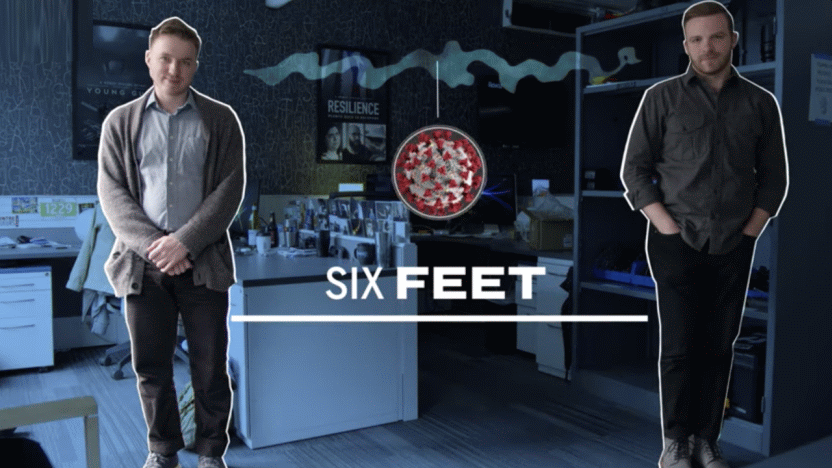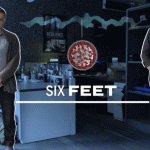New MIT study shows there’s NO benefit to CDC 6-feet social distancing rule: “We need scientific information conveyed to the public in a way that is not just fearmongering but is actually based in analysis”

For over a year now, we’ve been told by the Centers for Disease Control and Prevention (CDC), World Health Organization (WHO), and other government health officials to stay 6 feet apart and wear masks to stop the spread of the deadly coronavirus. Many states quickly seized the opportunity to impose “Draconian” rules and implemented harsh lockdowns and strict mask mandates.
Now, it turned out that you’re no safer from Covid indoors at 6 feet or 60 feet, according to a new study conducted by the Massachusetts Institute of Technology (MIT) scientists who challenge social distancing guidelines adopted across the world. The study shows that the risk of being exposed to Covid-19 indoors is as great at 60 feet as it is at 6 feet — even when wearing a mask.
The two researchers question the long-held COVID-19 guidelines from the CDC and the WHO in a peer-reviewed study published in Proceedings of the National Academy of Science of the United States of America. “We need scientific information conveyed to the public in a way that is not just fearmongering but is actually based in analysis,” Bazant said, according to a report from CNBC.
The study, which was released this week, was co-authored by MIT professors Martin Z. Bazant, who teaches chemical engineering and applied mathematics, and John W.M. Bush, who teaches applied mathematics. The two scientists suggested that the only way to reduce the spread of COVID-19 is to limit exposure to highly populated areas and areas where people are physically exerting themselves, such as gyms, or areas where people are singing or speaking, such as churches.
As part of the study, Professors Bazant and Bush developed a method of calculating exposure risk to Covid-19 in an indoor setting that factors in a variety of issues that could affect the transmission, including the amount of time spent inside, air filtration and circulation, immunization, variant strains, mask use, and even respiratory activity such as breathing, eating, speaking or singing.
“We argue there really isn’t much of a benefit to the 6-foot rule, especially when people are wearing masks,” Bazant said in an interview. “It really has no physical basis because the air a person is breathing while wearing a mask tends to rise and comes down elsewhere in the room so you’re more exposed to the average background than you are to a person at a distance.”
In conclusion, Professors Bazant and Bush said:
“Above all, our study makes clear the inadequacy of the SixFoot Rule in mitigating indoor airborne disease transmission, and offers a rational, physically informed alternative for managing life in the time of COVID-19. If implemented, our safety guideline would impose a limit on the CET in indoor settings, violation of which constitutes an exposure for all of the room’s occupants.”
Below is the abstract of the study
Abstract
The current revival of the American economy is being predicated on social distancing, specifically the Six-Foot Rule, a guideline that offers little protection from pathogen-bearing aerosol droplets sufficiently small to be continuously mixed through an indoor space. The importance of airborne transmission of COVID-19 is now widely recognized. While tools for risk assessment have recently been developed, no safety guideline has been proposed to protect against it. We here build on models of airborne disease transmission in order to derive an indoor safety guideline that would impose an upper bound on the “cumulative exposure time,” the product of the number of occupants and their time in an enclosed space.
We demonstrate how this bound depends on the rates of ventilation and air filtration, dimensions of the room, breathing rate, respiratory activity and face mask use of its occupants, and infectiousness of the respiratory aerosols. By synthesizing available data from the best-characterized indoor spreading events with respiratory drop size distributions, we estimate an infectious dose on the order of 10 aerosol-borne virions.
The new virus (severe acute respiratory syndrome coronavirus 2 [SARS-CoV-2]) is thus inferred to be an order of magnitude more infectious than its forerunner (SARS-CoV), consistent with the pandemic status achieved by COVID-19. Case studies are presented for classrooms and nursing homes, and a spreadsheet and online app are provided to facilitate use of our guideline. Implications for contact tracing and quarantining are considered, and appropriate caveats enumerated. Particular consideration is given to respiratory jets, which may substantially elevate risk when face masks are not worn.
You can read the detailed study here.

